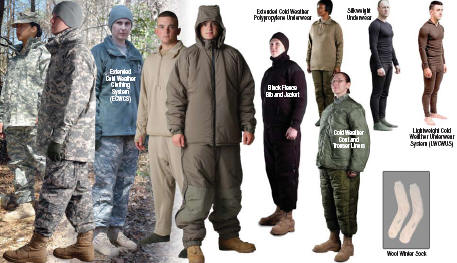Excitement Heating Up Over New Extended-Cold-Weather Gear
Dec 14, 2006
BY Donna Miles, Armed Forces Press Service
FORT GREELEY, Alaska, Dec. 14, 2006 – Members of the Alaska Army National Guard here are sizzling with excitement about their new cold weather gear that keeps them toasty warm even when temperatures dip to double digits below zero.

The new Generation III Extended Cold Weather Clothing System takes the latest insulating and wicking materials that have become hot tickets among skiers, snowmobile riders and other extreme-sports enthusiasts and adapting them for soldiers operating in demanding arctic conditions, explained Army Maj. Joe Miley, operations officer for the Alaska Guard’s 49th Missile Defense Battalion. “It’s designed to work in extremely cold weather,” he said.
Unit members got the new, layered system about two weeks ago, just in time for the coldest part of the season here, when the “Delta winds” bring in sustained 60-mph winds, with higher gusts, and temperatures can hit minus-60.
Those conditions make soldiering pretty demanding, explained Army Sgt. Seth Paul, a military policeman for the unit who patrols the Missile Defense Complex on some of those bone-chilling days. They gel up diesel fuel in vehicles and fray or split belts, freeze up weapons systems, and render radios unusable.
Such conditions can take an even bigger toll on troops, particularly those serving outside over extended periods.
The new ECWCS gear, with 12 components that can be mixed and matched depending on the conditions and how active a soldier is, offers the critical protection soldiers here need to do their jobs, Miley said.
The system begins with silky long underwear that’s made of lightweight, moisture-wicking polyester designed to keep the wearer dry. The mid-weight shirt and pants provide light insulation during warmer days or an extra layer in colder conditions.
The hands-down favorite piece of gear among the Guardsmen here, the green fleece jacket, offers a snuggly replacement for the Army’s heavy black fleece jacket. “It’s lighter and warmer, and it’s modeled after animal fur,” Paul said.
On colder days, soldiers can top the fleece with a lightweight, waterproof windbreaker or a breathable soft shell set designed for cold, rainy ways. A waterproof layer offers even more protection in prolonged, hard rain. During the coldest days, troops can add a puffy, extreme-cold-weather parka with high-tech insulation quilted into it and matching pants that zip over other layers in the system.
After two weeks wearing the new gear, the Alaska Guardsmen here give it a unanimous thumbs-up. “I love it. It’s comfortable as pajamas, but still looks really professional,” said Sgt. Katja Paul, an MP who makes up half of one of the husband-wife teams within the 49th Missile Defense Battalion here.
“It’s easy to take care of. You wash it and dry it, and you’re ready to go,” she said. “And the real beauty of it is that the whole system can be easily folded up and put in your rucksack.”
Army Spc. Anthony Montoya, a battalion communications operator, touted the new gear’s breathability, even during heavy activity. “It works well on the range. It’s comfortable and lets you move around, but it’s still light and compressible,” he said.
Seth Paul admitted to putting the new gear to the test “on Army time and off Army time,” including snowboarding in his off-duty hours. “It’s great stuff,” he said. “You can get it soaking wet on the outside and it still keeps you warm and dry.”
The new ECWCS gear is slated for initial fielding to the Army in about a year, but the 49th Missile Defense Battalion and a few other units received it ahead of schedule, based on their mission. The Fort Drum, N.Y.-based 10th Mountain Division received it in 2005, in time for its deployment to Afghanistan.
Lt. Col. Christopher Cavoli, commander of the division’s 1st Battalion, 32nd Infantry Regiment, offered the new system his highest praises after seeing its effectiveness in Operation Mountain Lion in the spring.
“During Operation Mountain Lion, I found myself praying for bad weather — the first time in my military career I was actually begging for a cold front to come through,” he said. “I knew my soldiers could handle it and the enemy couldn’t.
“The ECWCS allowed my men to outlast the enemy on their own terrain,” Cavoli said. “When the enemy was forced out of the mountains due to the bitter cold to take shelter, that’s when we got them.”